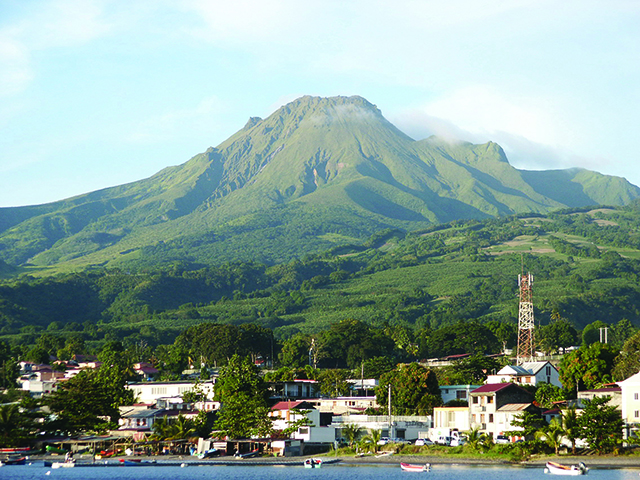Exploring St. Pierre, Martinique from the ground up (published July 2012)
On a close reach in 15 to 18 knots, headed for the beach of St. Pierre, Martinique, I was told to “go get the anchor ready.” Anchoring under sail between the local fishing boats moored off the beach was going to be tricky, I knew, especially since we were coming in fast, heeled 20 to 25 degrees. Once I unpinned the anchor and allowed it to dangle over the bow pulpit, I turned to give Dave the okay sign. He confirmed with “Ready.” I heard him shouting orders to the boys, but didn’t catch any words. I was looking at him, waiting for the head nod that means “Drop it.” What I got instead was a headshake along with “No, no, no! Coming about.” On the bow, ready to drop the anchor while we are flying our 130 genny, that means “Duck!”
We circled around, the boys on the genny sheets, Dave at the helm running the mainsheet. Confident that he had enough help, I stayed on the bow as we came back to what seemed like the exact spot. Still heeled with the anchor perched over the bow pulpit, I again put the handle in the clutch and waited. The head nod came, and from the boat’s motion and the speed of the chain exiting the hawse pipe, I knew we were going much faster than normal when we anchor, even though the crew had furled the headsail and the main was sheeted out. I tried to slow the chain at three marks (90 feet), but the boat’s forward speed would not allow it. Finally, at one mark (150 feet) I could gradually tighten the gypsy to stop the chain and attach the snubber after Eurisko jerked her bow into the wind. Once the snubber was secured, I joined Dave in the cockpit.
“What was that? We came in a little hot, huh?”
“Yeah, we were doing 3 knots when I had you drop it, but she wouldn’t slow down, and I couldn’t head her up in here with these little boats around. Besides, the wind is coming from everywhere.”
“Three knots, are you crazy? What if she didn’t catch?”
“We were going to head back offshore and try again.”
“Speaking of which, what happened the first time?”
“We were doing 6 knots.”
We are hard pressed to get Eurisko to do 6 knots when we try. What we had not anticipated was that Mount Pelée, seven miles to windward, would have such a dramatic effect on the wind’s direction and speed in the anchorage at St. Pierre.
ARE WE THERE YET?
Since there is no customs agency in St. Pierre, we had checked out of Martinique in Fort de France, having been assured by the agent that we had three days to leave their waters and a side trip to St. Pierre was perfectly acceptable. We sailed the 20 plus miles along the west coast of Martinique and anchored among the fleet of small fishing boats. Mother Nature was cooperating enough for us to spend a few nights in this fair-weather anchorage, and the next morning I was eager to start exploring. As a former French teacher, the history of St. Pierre’s destruction in the 1902 explosion of Mt. Pelée has always fascinated me. I used to dream along with my students of someday climbing this majestic volcano.
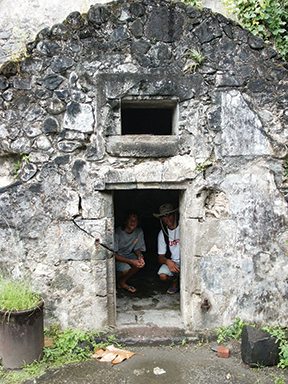
As is typical for us, we went to shore early the next day with my camera, water, snacks and lunch—baguette, sausage and cheese—but no plan other than to get to the top of Mt. Pelée. The recently rebuilt fishing pier in St. Pierre makes an excellent dinghy dock, and along the waterfront was a large vegetable and fish market. From there we walked up a slight hill, away from the town proper and toward the ruins of the old city. Much of the theatre is still identifiable, though the walls are only a few feet high. The jail cell where Cyparis, one of only a few survivors, was imprisoned is also still standing. We explored the foundations, steps, walls and streets of the ruined city as a light drizzle fell, the weather matching our somber moods as we moved through the area where 30,000 people lost their lives in a matter of minutes.
Though we had no land map, our goal was visible in the distance, so we wandered toward it, always moving upward. We found the tourist office, which was closed on Sundays, so we were not sure if there was any public transportation. We decided to walk in the general direction of the mountain and see what happened. After about three miles, we got a ride from a friendly islander who took pity on the soggy American tourists. He drove us to the town nearest Pelée. From there it was another two or three mile walk to the base of the mountain, then 4800 feet up. At some point one of the boys asked, “But how do we get home?” to which an overconfident parent replied, “We’ll worry about that later.”
At the official trailhead are bathrooms, a snack bar and a small restaurant complete with scenic overlooks, from which we could still see the anchorage in the distance. Here we refilled our water bottles and prepared for the long hike up.
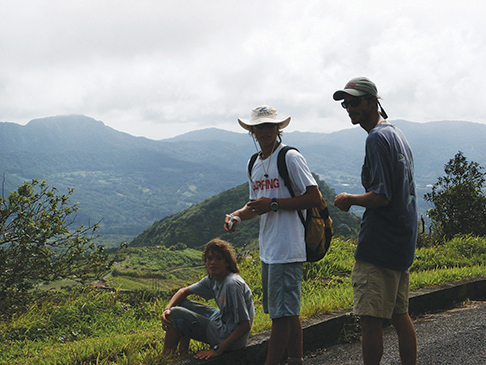
Dave and I can go years without ever wearing real shoes, so the fact that we would be climbing in flip-flops was not surprising. The hikers we encountered along the trail, however, discussed our chosen footwear in several languages. The boys caused an even bigger stir by deciding it would be easier to climb barefoot. They climbed much more quickly than Dave and I, so we agreed to meet for lunch at the head of our current trail. Exhaustion forced me to rest several times along the way, and we often received encouragement from those descending: “You’re almost there!” Like a kid in the backseat on a long car ride, I didn’t believe them. There are several “tops” to Mt. Pelée. Our trail ended at a nice plateau, big enough for the four of us to sit and enjoy the view as we ate our lunch.
ALTERNATIVE TRANSPORTATION
After we had eaten, the boys asked if they could follow the next trail that led along a ridge, down into a valley, then up to the “real” top of Mt. Pelée. More sensibly, Dave and I considered the long trip home still ahead of us and the work left to do on board to get Eurisko ready to travel the following morning. We decided we were close enough to the top to have earned bragging rights, so we gave the boys all the money we had (less than three euros—I don’t know what we expected them to do with that little money), our remaining food and half the water. More than 4,000 feet up, 12 miles from home, five hours before dark, with very little food, water or money, on an island whose language they don’t speak, we left our children with strict instructions to “Be home by dark,” and headed down the mountain as they ran up the next trail.
For the next four hours, as we trudged back toward St. Pierre, we wondered if what we had done was normal (no), a good idea (probably) and what was best for the boys (definitely). We decided that at 12 and 17 years, (our middle son had stayed home) they had better be able to take care of themselves and find their way home or we had failed at our job as parents.
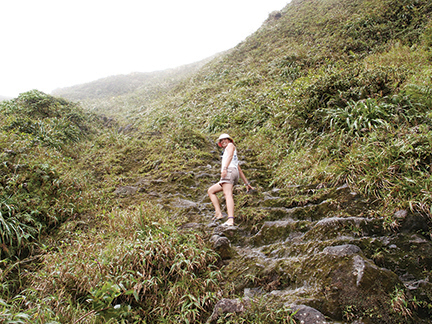
A half-mile from St. Pierre, less than an hour before dark, just as we were starting to think we may actually make it, a pickup truck passed us, then pulled over. Our oldest son, Nicholas, stuck his head out the window and yelled, “Get in the back, guys. You walked all this way? Ha! We got a ride.” On their way down the mountain, the boys had met a man who was picking wildflowers for his girlfriend, who lived in St. Pierre. They helped him collect his bouquet; in exchange he offered them a ride back, even picking up their bone-weary parents just outside of town. We could have climbed the rest of the way up with them and not walked as far.
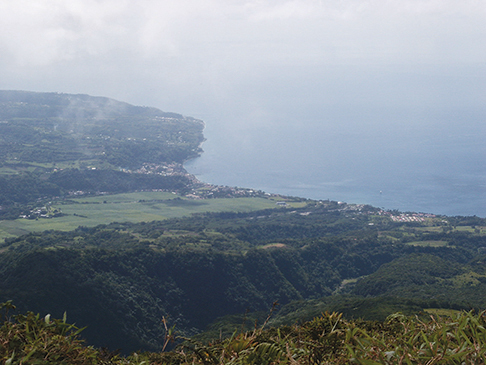
Our ride dropped us off in St. Pierre, now a small village of just over 4,000 people. We bought a few provisions at the 8 à huit, a convenience store. Water can also be purchased here in 15 liter jugs, but a large deposit is required on each container. We wandered through the town that sprang from the ashes over a century ago, marveling at man’s resilience in the face of disaster. Mt. Pelée has erupted several times since 1902 and is still considered one of the most active volcanoes in the eastern Caribbean. If you’re feeling brave and the weather allows, swing into this roadstead anchorage for a day or two. Drop the hook along the beautiful sandy shores of western Martinique. Explore St. Pierre, the new and the old. Marvel at the architecture, sounds and smells of Europe in the Caribbean. But when the looming summit beckons, may we recommend taking the bus.
Connie McBride, her husband and their three sons sailed away on their 34-foot Creekmore in 2002. Since then they have explored much of the Caribbean. You can read about their adventures in Panama in her new book, Eurisko Sails West: A Year in Panama, available at Amazon and on www.simplysailingonline.com.

















